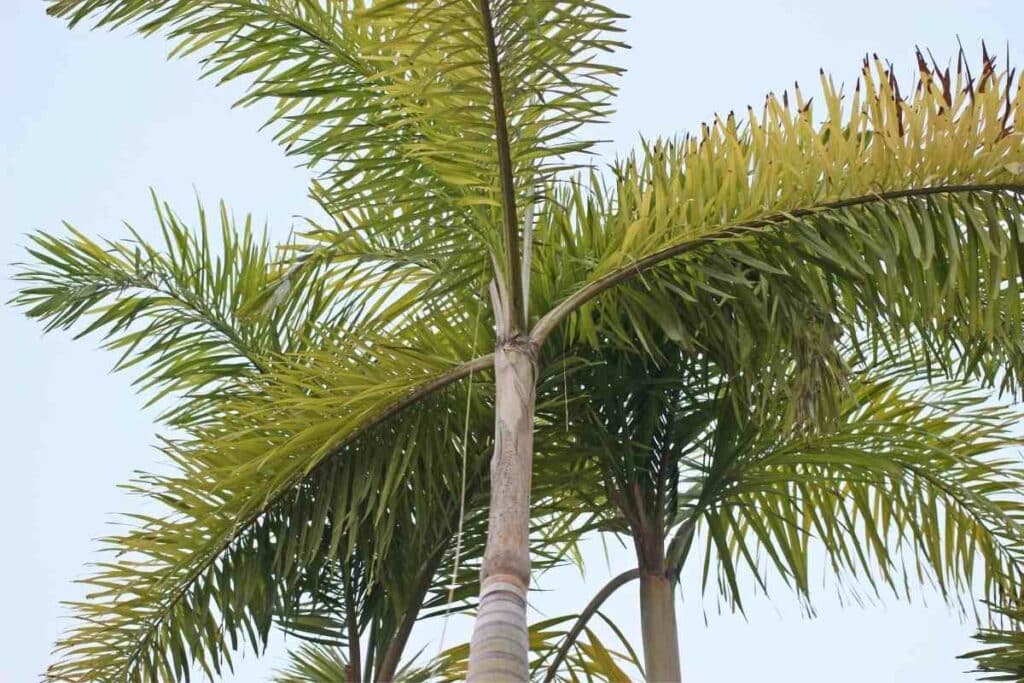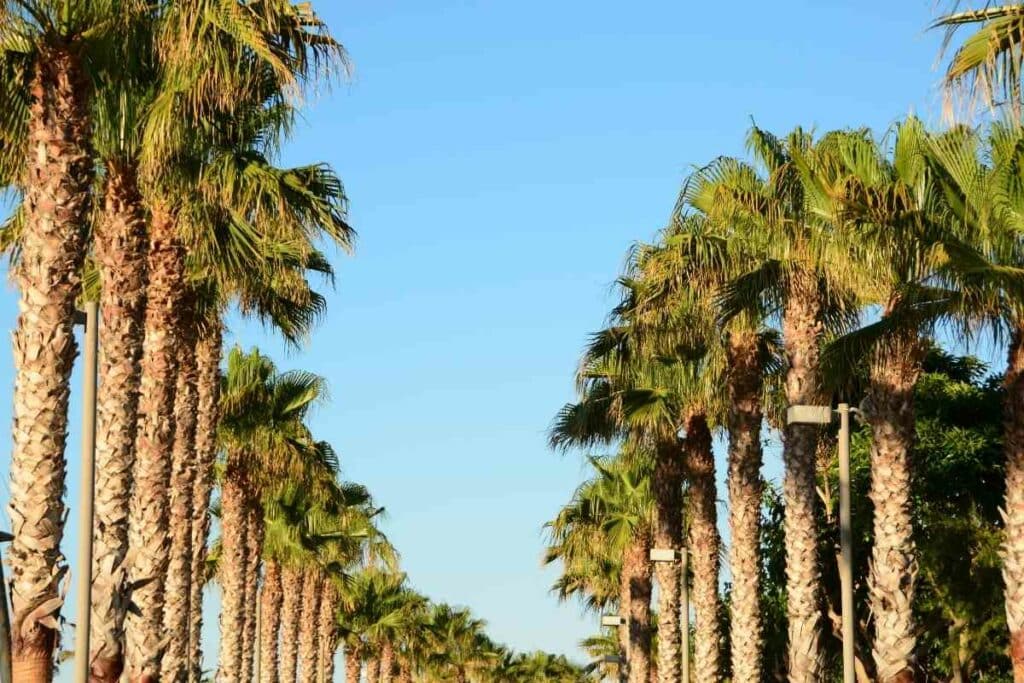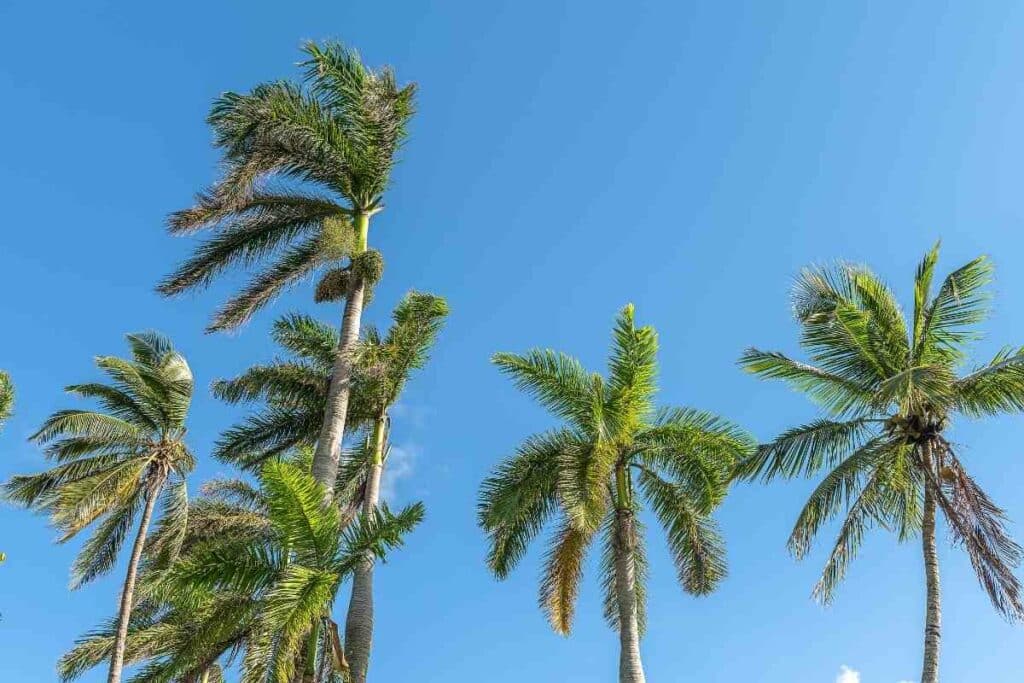In the right weather conditions and region, palm trees can grow up to as high as ten inches or about 1-foot-long every year.
Although palm trees can survive in any climate, they grow taller and faster in a warm environment.

Palm trees are often associated with tropical, exotic locations, and although they grow faster there, some species can thrive in cold regions, others indoors.
You only need to take regular and proper care of them.
If you want to turn your home garden into a tropic-like oasis, palm trees are the perfect addition.
Depending on Your Location – Different species of palm trees vary in how fast they grow, the attention required, their full height at maturity, and their lifespan. Outdoor palm trees grow faster than indoor plants because they enjoy the perfect conditions.
How Big Do Palm Trees Get?
Palm trees species grow to different lengths depending on various factors.
The recorded world’s tallest palm tree species grow up to 200 feet long.
Found in the Columbian Andes, researchers currently protect these wax trees as an endangered species.

Shorter species of palm trees grow up to about 10 feet long and include the dwarf species mostly grown indoors.
Most landscapers and gardeners recommend that homeowners grow the dwarf variety to about 3 feet.
They are perfect if one has a small yard and is keen to have a green space.
The lifespan of palm trees
Palm trees can live up to about nine decades, although this varies depending on the species and location.
The coconut palm tree is said to have the longest life span, with most thriving up to 100 years.
Because palm trees grow faster and taller in a warm or tropical climate, their lifespan in this environment is also the longest.

Palm trees in cooler temperatures grow to between 30 to 60 years. Fast-growing palm trees do not necessarily last longer because rapid growth can weaken the limbs.
Keep In Mind: If you forget to water or overwater indoor palm trees, they may die before they mature.
The fastest-growing palm trees
Palm trees are monocots from the Palmae or Arecaceae family of flowering plants.
Worldwide, there are over 2000 species of palm trees, with about a dozen being native to the US continent.

Despite the fast growth of palm trees, depending on the species, there are a few factors that encourage palm trees to grow faster:
- Sunlight. The sun is the most vital element that palm trees require to grow fast. Ensure your outdoor plants are grown where they have direct access to the sun, and leave your indoor plants where there is sufficient light.
- Soil. Palm trees have deep roots, and for them to grow sufficiently, they require proper drainage and fertilizers to enrich the soil.
- Water. Sufficient water is key to palm trees. For the deep roots to absorb enough water, regular watering of the plants is necessary.
- Trimming. As a palm tree grows, regular pruning of the brown fonds during dry weather allows the top of the tree to get enough nutrients.
The natural growth of palm trees is vital as rapid growth is sometimes hazardous.
Palm trees, especially the coastal/tropical species, are affected by harsh weather conditions like:
- solid winds
- storms
- and hurricanes
Palm trees that grow in dense forests compete with other tree species for the same resources, mainly sufficient sunlight.
The below chart shows the average lengths in feet per year five fastest-growing palm trees attain:

California Fan Palm
Scientifically named Washingtonia Filifera, you will find this tropical palm tree growing naturally in parts of California, Arizona, and Mexico.

It has a large wide trunk of about 3 feet in diameter, rises to as high as 60 feet long, and lasts above 80 years. Yearly, it grows up to 3 feet long.
The fan-shaped leaves are green on top, while the brown dead leaves form a protective barrier along the middle and bottom of the trunk.
You will tend to find bird nests and rodents living there. It thrives in wet soil with a high PH.
Carpentaria Palm
Scientifically known as Carpentaria Acuminata, this palm tree grows in Florida.
Native from Northern Australia, Carpentaria palm does well near bodies of water with high salt content.

It has a smooth trunk, is wider at the base, gets as high as 30 feet tall, and grows for about 50 years.
Annually – It can grow up to 6 feet long. Its green leaves are shaped like feathers and appear blue-green on the underside.
Mexican Fan Palm
Scientifically called Washingtonia Robusta, the leaves of this palm tree are similar to the California Fan species.

Landscapers love it due to its eye-catching appearance and ability to survive in cold areas.
It requires little water but grows faster if watered regularly. It is cheap to maintain both indoors and outdoors.
It’s commonly found in:
- Texas
- Oregon
- Georgia
- Louisiana
- and Arkansas
Native from dry Mexico, its large green leaves give a tropical appearance.
It can grow to 40 feet tall and requires regular trimming of the dry leaves on the shaft to maintain its striking look.
Yearly growth is about 4 feet and can last nearly 100 years.
Royal Palm
Scientifically named Roystonea Oleracea, this regal palm tree is native to North and South America and the Caribbean.

This tree flourishes in warm coastal environments like Texas, South Florida, and California.
It is enormous with a tall trunk, wide branches that give good shade requiring a lot of sunlight, and moderate water with proper drainage.
As a Result – With a yearly growth of about 1 foot, it can get as tall as 70 feet and lasts up to 150 years.
Queen Palm
Scientifically called Syagrus Romanzoffiana, this palm tree is perfect for shade in a garden.

Native from Argentina and Brazil, the Queen palm tree grows well in semi-tropical areas and can tolerate cold weather.
It has a short trunk with shallow roots, easily damaged in hurricanes or strong winds.
The leaves appear to grow upwards, and they can get 40 feet tall with 2 inches of annual growth.
It produces a sweet-smelling fruit that is inedible. It requires water and fertilizer to grow fast and healthy and lasts above 70 years.
Commonly asked questions About palm trees
What is the purpose of palm trees?
Besides providing shade and pleasant landscaping, palm trees have provided food, shelter, and medicine for thousands of years.
Can I speed up palm tree growth?
Although palm trees are tropical and drought-resistant plants, they grow faster if watered regularly.
However, the different species do not grow at the same speed.
Can I stop my palm tree from growing taller?
No, you cannot stop a palm tree from growing taller.
A palm tree grows from a tip at the top where all the fonds and leaves sprout from, and you can only stop it from growing tall by cutting it down.
If you cut the tip, the tree will die off.
Can palm trees survive cold weather?
Some species can survive cold weather, although you will have to protect the trunk from bursting open during extreme cold seasons.
If part of the tree trunk is damaged, the tree starts to rot and die.
Conclusion
If you live in a warm location, palm trees will do well in your garden. Pick the trees that will fit the size of your home or yard.
Consider choosing the dwarf variety for indoor plants as they will not outgrow the space.
Although the colder environment’s palm trees will not grow similarly, they will get to an impressive size in no time.
Palm trees are versatile plants and can transform any place into an ideal and cozy tropical oasis.


